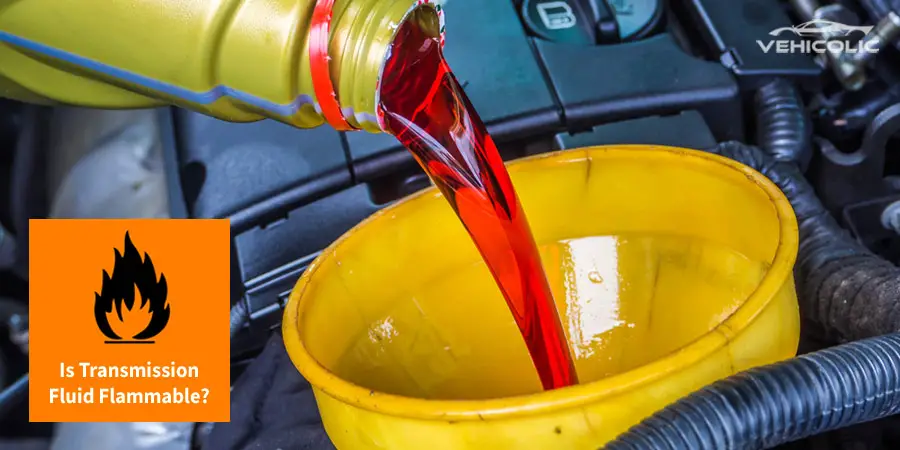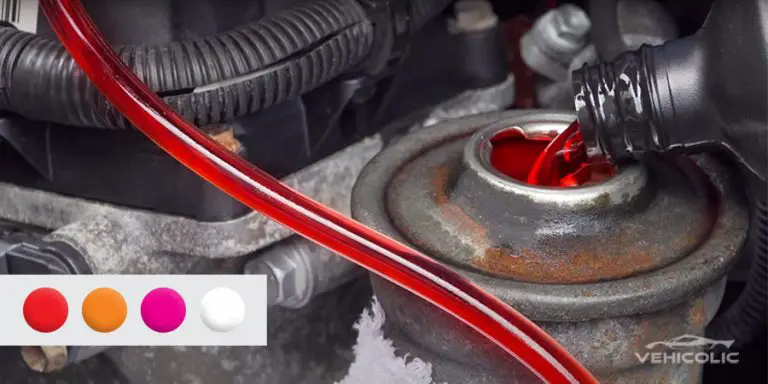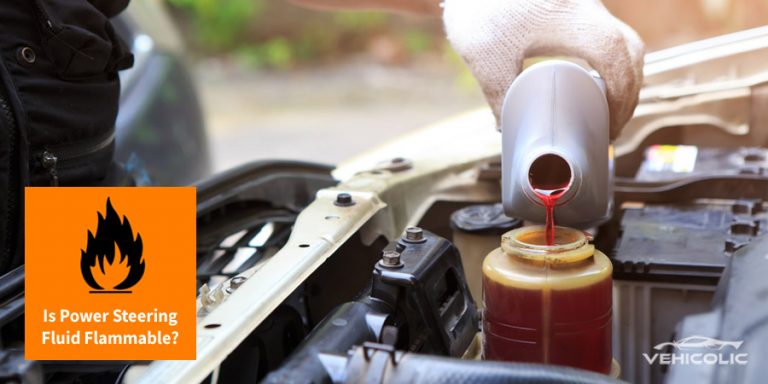Is Transmission Fluid Flammable?
Transmission fluid plays a vital role in automatic transmission vehicles and helps in self-shifting. Typically, the fluid is red and sometimes green.
The color variation distinguishes it from other car oils to avoid confusion. Is transmission fluid flammable? The answer to these questions helps us know how careful one should be when handling the fluid around high temperatures.
First, it’s important to note that the fluid brings functionality to your valve operation and friction to the brake band. It also brings functionality to your torque converter and lubricates your car gear.
The fluid is a mixture of additives and base oil. Transmission fluid retains its protective properties even as it works under extreme conditions like high temperatures.
Role of the Transmission Fluid
Transmission fluid is crucial to the transmission unit, which converts the rotational energy to the car wheel initiating motion. The fluid helps the transmission system runs perfectly.
- Lubricates the gears
- Cleans metal parts and protects the surfaces
- Improves cooling
- Reduces the operational temperature
- Boosts the rotational speed
- Conditions the gaskets
Is Transmission Fluid Flammable?
Not under normal conditions. The fluid is combustible and ignites when heated beyond the flashpoint. The flashpoint of transmission fluid is 302 to 383 degrees Fahrenheit.
A vehicle has many fluids except gasoline; almost all of them are not flammable under normal conditions.
Transmission fluid only ignites when the temperature goes beyond the flashpoint. It means that temperature determines the flammability of the fluid. It explains why transmission fluid is considered chiefly combustible.
What is the Flammability of the Transmission Fluid?
There are two types of transmission fluids; manual and automatic. Combustible is a broad term, and all flammable fluids are combustible.
Transmission fluids support burning flame as long as the temperature is right. To determine flammability, consider the fluid flash point and boiling point. A flammable substance has a flashpoint that is lower than its boiling point.
The flashpoint is the temperature at which the fluid vapors and ignites. For transmission fluids, that temperature is between 303 and 383 degrees Fahrenheit. The boiling point of the transmission fluid is 550 – 600 degrees Fahrenheit.
What does a high flashpoint mean? It means that your transmission fluid will not be the first cause of vehicle fire because it can’t easily ignite. However, it can still cause a fire, but it will be a secondary fire. For instance, if your vehicle is already on fire, the fluid will make it continue burning.
However, there are exceptional cases like spilled transmission fluid on a hot engine part causing a fire. The engine has to be very hot for that to happen.
The fluid sprays can auto-ignite because the mist is very volatile and can easily auto-ignite below the fluid flashpoint.
Safety is vital when handling transmission fluids. Sort out any leaks immediately to prevent a fire hazard. A transmission fluid leak means that you have a punctured plug or one of your plugs is loose.
How to Safely Handle Transmission Fluid
As much as transmission fluid has a high-temperature requirement for burning or auto-ignition, handle it carefully. Observe the following safe handling tips.
- Store the fluid in clearly labeled packages, preferably in their original containers and always keep the fluid or container out of reach of your pets or kids.
- Keep the transmission fluid away from open fire sources to preventing it from auto-igniting and starting a fire. Be aware of the transmission fluid mists or sprays as it easily ignites below the flashpoint.
- Dispose of your transmission fluid safely following the same process of motor oil disposal. Drop off the used container at the proper mineral oil disposal bin or an oil incinerator for burning.
- Be on guard for leaks to prevent fire hazards. Watch out for leak symptoms like grinding gears, noticeable leaks, burning smells, acceleration problems, and clunking sound. If you see a leak, consult an expert mechanic for immediate remedy.
How to Check Your Transmission Fluid?
Just like other vehicle fluids, transmission fluid worsens over time and will need changing. Always check your vehicle owner’s manual to know how to go about it.
I strongly recommend that you do the checking at the service center. Observe the tips below when checking your transmission fluid.
- Use the owner’s manual to know the correct standard to check your fluid.
- Park the car on level ground to get an accurate transmission fluid reading.
- Ensure the engine and transmission fluid at an operating temperature before checking.
- Checking the fluid when the engine is off or running affects the accuracy.
- Some vehicles require you to move the gear selector for a few seconds before checking your fluid. First, return to neutral and try your parking brake earlier before you get out of the vehicle.
- Locate the transmission dipstick (has a bright color), refer to the owner’s manual.
- Carefully remove your dipstick, then wipe it off using a neat rag.
- Remove your dipstick and check the transmission fluid level, fill it up to the recommended level, and fix the leak.
- Install the dipstick once you are finished.
Transmission fluid needs changing if any particle gets inside. Do routine car service at a reputable service center.
Expect to pay for a transmission-fluid transition. The manufacturer’s recommendations decide when you need fresh fluid.
FAQs
What is transmission fluid, and what color is the transmission fluid?
The standard color is red or green. The color is because of the additives like antifreeze, engine oils, and brake fluid. New transmission fluid is primarily translucent, bright, and vibrant red.
When the transmission system is in operation, the components get hot, and the fluid prevents those components from overheating. Therefore, the fluid is vital for your overall vehicle performance.
Is transmission fluid the same as power steering fluid?
No. The two are different fluids and have different uses. The power steering fluid lubricates power steering parts, applies hydraulic pressure, reduces temperature buildup to facilitate steering.
However, transmission fluid cleans and lubricates transmission components like gears. The only common thing about the two fluids is that they are both hydraulic fluids.
What is the Flash Point of Automatic Transmission Fluid?
The transmission fluid has a flashpoint between 303 and 383 degrees Fahrenheit or 159-195 degrees Celsius. However, this depends on your type of transmission fluid.
The temperatures are higher than the average operating temperature in the vehicle. Still, the temperatures can be achieved under certain circumstances, like the car catches a primary fire which auto-ignites the transmission fluid.
What Makes Transmission Fluid Overheat?
Primarily because of low transmission fluid making it work much harder, causing overheating. An overworking transmission fluid overheats, losing its ability to cool the transmission components quickly.
It makes the problem worse and causes more damages. Also, failing to change an old or worn-out, or burnt transmission fluid causes overheating as the fluid doesn’t cool efficiently.
Oxidation breaks down the fluid with time leading to overheating because of the increase in friction level.
Can I Use Motor Oil For Transmission Fluid?
Both motor oil and transmission fluid are vital in the optimal working of the vehicle’s engine system.
The motor oil is primarily designed for the engine, while transmission fluid works with the gear system and steering. Therefore, the two fluids may be similar but cannot be used in place of the other. So, NO, don’t try.
At What Temperature Does Transmission Fluid Ignite?
The transmission fluid can ignite or catch fire when the heat goes beyond 400 degrees Fahrenheit. At this point, the fluid catches fire and supports burning—the mist and spray from the flame light up at a lower temperature than the flashpoint.
Is transmission fluid a hazardous material?
Transmission fluids are marine pollutants but are not considered hazardous waste. However, safe disposal prevents ingestion which leads to gastrointestinal problems.
Be careful not to get the fluid in your eyes. If there is contact, wash with plenty of running water, then seek medical attention.
Transmission fluid can only be hazardous when mixed with dangerous substances or solvents, primarily dumped in landfills.
Final Thoughts
The transmission fluid is flammable if it gets overheated and is combustible under average temperatures. Handle the fluid safely by following the safety tips given above to prevent fire hazards. Pay special attention to the recommended environmentally friendly methods.
Transmission fluid is a utility in the transmission system in your vehicle. The fluid ensures your gears run smoothly and cleans them up. Also, the fluid lubricates your metal; parts.
The flammability of the fluid gives you a deeper understanding of the nature of the liquid to ensure you handle it well and avoid creating a fire hazard. Always check the fluid level as recommended by the vehicle manufacturer in the owner’s manual.






